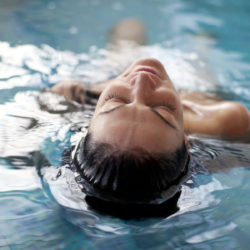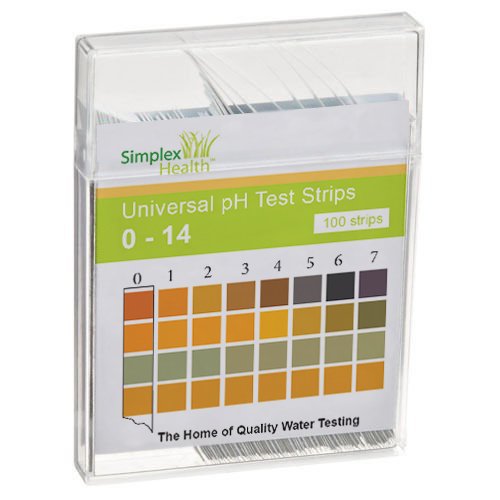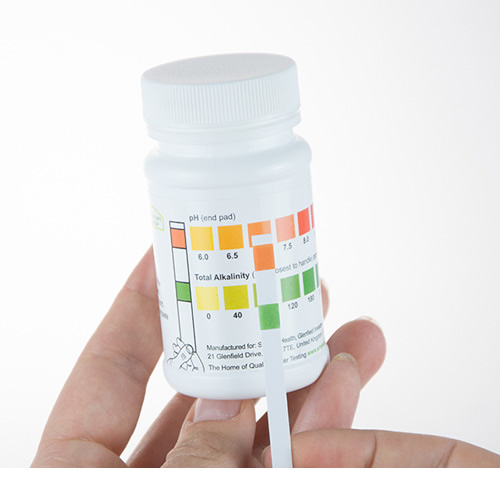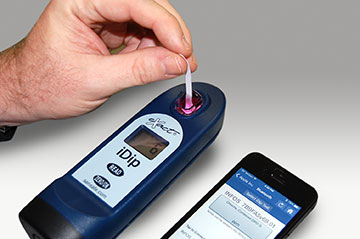
All hot tubs require regular maintenance to keep the water clean and safe for bathers. Hot tubs are treated in a similar way to swimming pools. There are some differences however, mainly because there is a smaller volume of water and the water is warm. Because of the heat, the chemical balance can constantly change. Therefore, it is important that the hot tub is monitored regularly so any changes can be detected early and acted upon. Generally, the amount of chemical used is measured in ppm (parts per million) or mg/l (milligrams per litre).
Once you have been testing and adjusting each element in the hot tub for a while, the maintenance will become a lot easier.
Content of this article:
- A) Elements which should be monitored
- B) How to test hot tub water and how often to test hot tub water
- C) General hot tub safety tips
This article has been written for hot tubs used in private homes. This guide is intended to provide a general introduction, it is by no means complete. Please always refer to the suppliers/manufacturers/installers guidelines to ensure safe and hygenic use. Although the content might also be helpful for people/companies whith hot tubs for public use (ie holiday rentals, hotels), please refer to specific guidelines and regulations for those, ie. Control of legionella and other infectious agents in spa-pool systems by HSE. For hot tubs & spas used by the public (like hotels, holiday rentals) regular laboratory testing is required (usually quarterly for legionella and monthly for bacteria) – we do offer testing by a UKAS approved lab, click here for details.
A) Elements which should be monitored
The key chemicals which should be monitored regularly include sanitiser (to kill bacteria keeping the water safe), pH level, alkalinity, total hardness, Total Dissolved Solids (TDS) as well as bacteria.
- Sanitiser – the main sanitisers used are chlorine or bromine, a choice you need to make is which chemical to use. In hot tubes, the amount of free chlorine should be 3-5ppm and bromine 4-6ppm.
- pH* level – the ideal pH for a hot tub is 7.2 – 7.6 (for chlorine users) and 7.0 – 7.4 (for bromine users). If the pH is outside this level (either too acidic or too alkaline) this can have a negative effect, therefore it is important to test the pH level regularly. If your hot tub is too acidic, then the sanitiser is less effective and can cause irritation to eyes but also damage parts of the hot tub. If the pH is too high (=alkaline) then the sanitiser can be less effective, plus the water can become cloudy and scale builds up. Once the current pH level has been tested, a pH decreaser or increaser can be used to change the pH levels.
- Alkalinity** – before you can start looking at pH levels, it is important to balance the alkalinity as it acts as a buffer and gives you the ability to better control the pH level of your hot tub. Alkalinity should be between 80 and 120ppm (anything above or below that will make it harder to adjust the pH level). Make sure to check the alkalinity again once the pH level has been adjusted, as the alkalinity might have changed.
- Total Hardness – measures the levels of dissolved minerals, most commonly this is calcium and magnesium. The ideal hardness reading is 100 – 250ppm. Too hard and there will be scale and cloudy water. Too low and it will force the water to draw from other minerals such as aluminium, copper and iron which can damage the parts of your hot tub that are built from these materials.
- Total Dissolved Solids (TDS): over time, minerals, chemicals and other soluble materials will lead to an increase of TDS in your water. This can reduce the effectiveness of chemicals, cause dull water and make it harder to maintain. Test for TDS at least once a month (depending on use etc). A monthly change of water is recommended.
- Bacteria – can grow within the hot tub, therefore it is recommended to check the level of bacteria regularly. Specially designed bacteria test strips for pool & spa detect E.coli, Pseudomonas and many other forms of bacteria in water and provide results within 15 minutes.
- Visually also check
- for foam, which can be caused by remnants of detergents left in bathing costumes, and
- check the filtration system is in good working order.
 pH is a scale of 0 to 14*and is used to measure how acid or alkaline a liquid is. A pH below 7 is acid, 7 is neutral and above 7 is alkaline. Very acidic water can destroy a hot tub and its working parts, but also irritate skin and eyes. Very alkaline water prevents the chemicals from doing their job of keeping the water clean, dry the skin, affect swim wear and make eyes red and itchy.
pH is a scale of 0 to 14*and is used to measure how acid or alkaline a liquid is. A pH below 7 is acid, 7 is neutral and above 7 is alkaline. Very acidic water can destroy a hot tub and its working parts, but also irritate skin and eyes. Very alkaline water prevents the chemicals from doing their job of keeping the water clean, dry the skin, affect swim wear and make eyes red and itchy.
 About alkalinity** If the alkalinity of your hot tub is too low, then the pH is unstable and can change easily. If the alkalinity is too high, then the pH will go up and make water cloudy and create scale on the surface of the hot tub. So before adjusting the pH level, check the alkalinity level and potentially change it.
About alkalinity** If the alkalinity of your hot tub is too low, then the pH is unstable and can change easily. If the alkalinity is too high, then the pH will go up and make water cloudy and create scale on the surface of the hot tub. So before adjusting the pH level, check the alkalinity level and potentially change it.
B) How to test hot tub water
1) Using test strips
Testing the water is key to keeping the water safe, clean and healthy. The easiest and most cost-efficient way to test is using test strips which indicate chlorine/bromine, pH, alkalinity & hardness quickly and accurately. Appropriate chemical adjustments can be made once the water has been tested.
To test, simply put your test strip into the water, hold it about 15cm under water, then take it out. Wait as instructed and then compare the colour change with the closest colour on the colour chart. Each pack of test strips comes with detailed instructions and a colour chart on the pack. If your tested elements are not within the required range, then you can adjust them.
- Quick Pool Test 5-in-1 (50 tests): free & total chlorine, pH, total alkalinity and total hardness.
- Easy Pool Test 3-in-1 (50 tests): free chlorine (bromine), pH and total alkalinity.
- Bromine Check (50 strips)
- Bacteria (10 tests) and Bacteria (2 tests): bacteria test strips for pool & spa detect E.coli, Pseudomonas and many other forms of bacteria in water and provide a result within 15 minutes
- Total Dissolved Solid (50 strips)
- Pool Check Phosphate (50 tests) Because phosphates are the primary food source for algae, the more phosphate, the more algae. High phosphate levels can produce resistant algae and interfere with the sanitising property of chlorine. Regularly testing for phosphates can help to ensure a properly maintained pool & spa.
Specialist strips for people who use other sanitisers:
- Copper Ionisation for sanitising: Pool Check 3 in 1 with Copper (50 tests)
- Monopersulfate (MPS) help to maintain and increase the life of your sanitiser: Pool Check Alkalinity, pH, MPS 3 in 1 (50 tests)
- Salt, ideal for any chloride generating unit: Pool Check Salt
To view the full range of our pool & spa testing products, click here.
2) Using a photometer
 The eXact photometer for Spas delivers labquality results when testing for 7 important spa parameters: free chlorine, total bromine, combined/total chlorine, pH, total alkalinity, calcium hardness. All tests have been specifically calibrated for spa temperatures and use reagent test strips for quick and reliable analysis. It is available in two options as a meter only or as a complete starter pack (meter and reagents).
The eXact photometer for Spas delivers labquality results when testing for 7 important spa parameters: free chlorine, total bromine, combined/total chlorine, pH, total alkalinity, calcium hardness. All tests have been specifically calibrated for spa temperatures and use reagent test strips for quick and reliable analysis. It is available in two options as a meter only or as a complete starter pack (meter and reagents).
To view the full range of pool and spa photometers, including our complete starter packs, click here.
3) With a laboratory test
We offer specific laboratory tests to detect bacteria in pools, spas and hydropools. A laboratory test will provide the most accurate test result in terms of type and amount of bacteria present:
- To test for Pseudomonas aeruginosa, Coliform bacteria, E.coli and Total Viable Count (TVC): Bacteria Analysis (4in1)
- To test for Legionella: Legionella Analysis
How often to test hot tub water
A hot tub should be tested at least once a week to ensure that the chemicals you add are at the right levels. It also helps to keep it clean and prolongs the life of the hot tub. Heavy use requires testing more often.
C) General Hot Tub safety tips
For any hot tub owner / user it is important to keep our safety tips in mind at all times:
- Do not allow hot tub temperatures to exceed 40℃ (lower if children will be using the hot tub)
- Shower before you get in
- Keep the lid on when not in use, it ensures nothing falling in
- Regularly replace the water before it gets cloudy and a film builds up on the surface*** , this is also a good opportunity to give the hot tub a good clean
- Never leave non-swimmers / children unattended in a hot tub
- Do not overload your Spa with more people than its recommended size
- Do not use electrical appliances near your hot tub
- Do not use glass around or in a Spa
- Do not drink alcoholic beverages before or while using a hot tub
- Clean the hot tub (don’t just rely on sanitiser) by wiping down the interior surface with an unbleached cloth or sponge
- Clean the filters regularly
- If you’re pregnant, have high blood pressure or any cardiovascular conditions please contact your doctor before using a hot tub
- Always wear gloves when cleaning / changing hot tub filter cartridges
*** How to know when to do that: Take the number of gallons of your hot tub holds when it’s full. Divide that number by the number of people who regularly use the hot tub. Then divide that number by three. This will tell you how often you should change the water. For example, a Coleman Lay Z Spa holds 254 gallons. If 2 people regularly use the hot tub, then 254 divided by 2 gives you 127. Now divide 127 by 3, and you get 42. That means you’ll need to replace the water every 42 days.
Further Free Resources:
Got a question about water testing? Try our complete list of Free Water Testing Resources. Here are the most frequently read guides:
- Click here to download our FREE Water Guide
- Read an overview of the potential contaminants in your water
- Why test your water and water supply?
- Unusual colours, smells and taste of your water & further advice on finding the right test kit
- How to choose the right Water Testing Kit
- Choosing the right water testing kit for a water improvement & purification system, water cooler or a pool, spa or hot tub
- How to understand the results of your Quality Water Test Kit
- How to test for lead correctly and what immediate steps can be taken to reduce lead exposure
- How to get the best drinking water – which water filter?
- How to check if my water filter is working?
- How to test the pH of soap?
- How to find the source of a leak in a property
- How to measure the pH of water & other liquids correctly
- How to look after your hot tub safely and test the water regularly
- What is best pH level for drinking water? How to measure the pH of water & other liquids correctly
- How to test the quality of Open Water for bathing or swimming
- Commercial Applications for Water Testing: Buyers Guide – Water Testing on vessels, ships as well as water tanks in remote locations
If you can’t find what you are looking for then please contact us, as we can source many other test kits. Discounts for bulk purchases available, please contact us to find out more.
Disclaimer: Only opinions based upon our own personal experience or information detailed in academic journals or other publications is cited. This has been done exclusively for anyone who is interested in this subject but is not intended to replace proper analysis. We cannot accept responsibility and liability of any kind which may result from the application of this information. We always recommend to consult an expert to discuss any test results or get a full recommendation on the specific subject and specific to your situation by an expert.
Please note, that our recommendation is only a guidance and may not be complete. Please inform yourself about local/industry specific regulations which apply to you. We cannot accept responsibility and liability of any kind which may result from the application of this information.
This information is owned by SimplexHealth and you do NOT have the right to reprint, sell, auction or distribute this information.
There are strict standards for the quality of drinking & bathing water within Europe mainly laid down in the EU Drinking Water Directive (98/83/EC). These are based on advice from the World Health Organisation (WHO).
